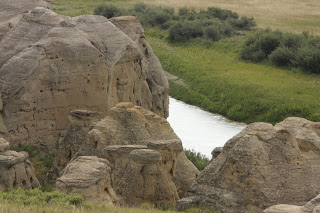Writing-on-Stone Bus Tour
For the past three years we have been collecting feedback about our bus tour programs and by far the most requested place for us to take a tour was Writing-on-Stone Provincial Park. In August, on our last bus tour of the season, we finally got a chance to go there.
On the drive to Writing-on-Stone our Blackfoot interpreter from the museum, Blanche Bruised Head, talked about Blackfoot history and culture. People on the bus asked lots of insightful questions and I think it really helped prepare people for the next part of the tour: the interpretive walk to see the petroglyphs and pictographs that cover the park's sandstone cliffs.
The petroglyph/pictograph part of the tour was led by Bonnie, a park interpreter. The tour normally takes about 1-1.5 hours, but ours ran a little long giving people lots of time to ask questions.
The walk required a park guide because we were in a protected area that is not otherwise open to the public. Some areas in the park are protected to preserve the pictographs and petroglyphs, while other areas of the park are open to the public. There is also a self-guided tour of the area that is a nice 4.4 km (return) walk.
The hoodoos, seen above, were created by wind and water erosion. First Nations people have lived in this area for at least 3,000 years. Some of the petroglyphs and pictographs they created here recorded important biographical or historical information. Other rock art would have been linked to their spiritual lives, including petroglyphs and pictographs that were created as a part of rituals and vision quests.
Petroglyphs are rock carvings:
Pictographs, in contrast, are paintings created with ochre which is a crushed iron ore mixed with water:
While the guests were on the walk in the protected area, my volunteer Tasha and I set up the picnic lunch. This, from a planning perspective, was the most challenging part of the tour! The bookable picnic shelters at Writing-on-Stone book up in January so we relied on getting to one of the first-come, first-serve shelters in the river valley. We booked Country Kitchen Catering to make buffalo (or bison) burgers and then we brought the burgers, pre-cooked in a warmer, out to the picnic shelter. There was salad and dainties for dessert.
Buffalo is a traditional food for the Blackfoot people so this opened up a conversation about traditional foods and we learned about some of the native plants of the area. For example, did you know that wild turnips grow in our coulees back in Lethbridge? Also, during lunch we served traditional Saskatoon Berry soup and bannock cooked by the Blackfoot Cultural Society. Our afternoon snack was buffalo jerky since buffalo meat was often preserved by drying and then used in various foods like pemmican. Mint tea, similar to what we served in the morning before the bus departed, is another traditional food from the area.
After lunch we went up to the interpretive centre for another tour with Bonnie (center in picture below), and for a chance to explore the exhibits and learn more about the history of the area.
Overall, the tour was a lot of fun and a really interesting way to learn about Blackfoot history. Blanche and Bonnie as our tour guides really did a great job of contextualising the rock art and explaining the historical themes. The volunteers, as always, were also a great help in making the day a success. I’m looking forward to doing this tour again in the future.








